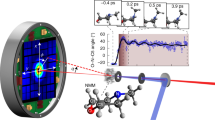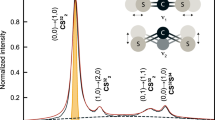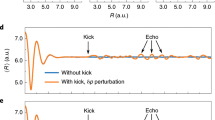Abstract
The motion of chemical bonds within molecules can be observed in real time in the form of vibrational wave packets prepared and interrogated through ultrafast nonlinear spectroscopy. Such nonlinear optical measurements are commonly performed on large ensembles of molecules and, as such, are limited to the extent that ensemble coherence can be maintained. Here, we describe vibrational wave packet motion on single molecules, recorded through time-resolved, surface-enhanced, coherent anti-Stokes Raman scattering. The sensitivity required to detect the motion of a single molecule under ambient conditions is achieved by equipping the molecule with a dipolar nano-antenna (a gold dumbbell). In contrast with measurements in ensembles, the vibrational coherence on a single molecule does not undergo pure dephasing. It develops phase fluctuations with characteristic statistics. We present the time evolution of discretely sampled statistical states, and highlight the unique information content in the characteristic, early-time probability distribution function of the signal.
This is a preview of subscription content, access via your institution
Access options
Subscribe to this journal
Receive 12 print issues and online access
$209.00 per year
only $17.42 per issue
Buy this article
- Purchase on Springer Link
- Instant access to full article PDF
Prices may be subject to local taxes which are calculated during checkout





Similar content being viewed by others
References
Moerner, W. E. & Kador, L. Optical detection and spectroscopy of single molecules in a solid. Phys. Rev. Lett. 62, 2535–2538 (1989).
Orrit, M. & Bernard, J. Single pentacene molecules detected by fluorescence excitation in a p-terphenyl crystal. Phys. Rev. Lett. 65, 2716–2719 (1990).
Betzig, E. & Chichester, R. J. Single molecules observed by near-field scanning optical microscopy. Science 262, 1422–1425 (1993).
Nie, S., Chiu, D. T. & Zare, R. N. Probing individual molecules with confocal fluorescence microscopy. Science 266, 1018–1021 (1994).
Eigen, M. & Rigler, R. Sorting single molecules: application to diagnostics and evolutionary biotechnology. Proc. Natl Acad. Sci. USA 91, 5740–5747 (1994).
Kulzer, F. & Orrit, M. Single molecule optics. Ann. Rev. Phys. Chem. 55, 585–611 (2004).
Kukura, P., Celebrano, M., Renn, A. & Sandoghdar, V. Single-molecule sensitivity in optical absorption at room temperature. J. Phys. Chem. Lett. 1, 3323–3327 (2010).
Moerner, W. E. A dozen years of single-molecule spectroscopy in physics, chemistry, and biophysics. J. Phys. Chem. B 106, 910–927 (2002).
Plakhotnik, T., Walser, D., Pirotta, M., Renn, A. & Wild, U. P. Nonlinear spectroscopy on a single quantum system: two-photon absorption of a single molecule. Science 271, 1703–1705 (1996).
Gaiduk, A., Yorulmaz, M., Ruijgrok, P. V. & Orrit, M. Room-temperature detection of a single molecule's absorption by photothermal contrast. Science 330, 353–356 (2010).
Barkai, E., Jung, Y. & Silbey, R. Theory of single-molecule spectroscopy: beyond the ensemble average. Ann. Rev. Phys. Chem. 55, 457–507 (2004).
Weiss, S. Fluorescence spectroscopy of single biomolecules. Science 283, 1676–1683 (1999).
Xie, S. Single-molecule approach to enzymology. Single Molecules 2, 229–236 (2001).
Hildner, R., Brinks, D. & van Hulst, N. F. Femtosecond coherence and quantum control of single molecules at room temperature. Nature Phys. 7, 172–177 (2011).
Brinks, D., Hildner, R., Stefani, F. D. & van Hulst, N. F. Coherent control of single molecules at room temperature. Faraday Disc. 153, 51–60 (2011).
Brinks, D. et al. Visualizing and controlling vibrational wave packets of single molecules. Nature 465, 905–908 (2010).
Hildner, R., Brinks, D., Stefani, F. D. & van Hulst, N. F. Electronic coherences and vibrational wave-packets in single molecules studied with femtosecond phase-controlled spectroscopy. Phys. Chem. Chem. Phys. 13, 1888–1894 (2011).
Novotny, L. & van Hulst, N. Antennas for light. Nature Photon. 5, 83–90 (2011).
Jeanmaire, D. L. & Van Duyne, R. P. Surface Raman spectroelectrochemistry: part I. Heterocyclic, aromatic, and aliphatic amines adsorbed on the anodized silver electrode. J. Electroanal. Chem. 84, 1–20 (1977).
Schatz, G. C. Theoretical-studies of surface enhanced Raman scattering. Acc. Chem. Res. 17, 370–376 (1984).
Nie, S. & Emory, S. R. Probing single molecules and single nanoparticles by surface-enhanced Raman scattering. Science 275, 1102–1106 (1997).
Kneipp, K. et al. Single molecule detection using surface-enhanced Raman scattering (SERS). Phys. Rev. Lett. 78, 1667–1670 (1997).
Etchegoin, P. G. & Le Ru, E. C. A perspective on single molecule SERS: current status and future challenges. Phys. Chem. Chem. Phys. 10, 6079–6089 (2008).
Zhang, R. et al. Chemical mapping of a single molecule by plasmon-enhanced Raman scattering. Nature 498, 82–86 (2013).
Link, S., Burda, C., Nikoobakht, B. & El-Sayed, M. A. Laser-induced shape changes of colloidal gold nanorods using femtosecond and nanosecond laser pulses. J. Phys. Chem. B 104, 6152–6163 (2000).
Voronine, D. V. et al. Time-resolved surface-enhanced coherent sensing of nanoscale molecular complexes. Sci. Rep. 2, 891 (2012).
Steuwe, C., Kaminski, C. F., Baumberg, J. J. & Mahajan, S. Surface enhanced coherent anti-Stokes Raman scattering on nanostructured gold surfaces. Nano Lett. 11, 5339–5343 (2011).
Namboodiri, V. et al. Surface-enhanced femtosecond CARS spectroscopy (SE-CARS) on pyridine. Vib. Spectrosc. 56, 9–12 (2011).
Ichimura, T., Hayazawa, N., Hashimoto, M., Inouye, Y. & Kawata, S. Tip-enhanced coherent anti-Stokes Raman scattering for vibrational nanoimaging. Phys. Rev. Lett. 92, 220801 (2004).
Frontiera, R. R., Henry, A.-I., Gruenke, N. L. & Van Duyne, R. P. Surface-enhanced femtosecond stimulated Raman spectroscopy. J. Phys. Chem. Lett. 2, 1199–1203 (2011).
Mukamel, S. Principles of Nonlinear Optical Spectroscopy (Oxford Univ. Press, 1995).
Karavitis, M., Zadoyan, R. & Apkarian, V. A. Time resolved coherent anti-Stokes Raman scattering of I2 isolated in matrix argon: vibrational dynamics on the ground electronic state. J. Chem. Phys. 114, 4131–4140 (2001).
Loudon, R. The Quantum Theory of Light (Oxford Univ. Press, 2000).
Kleinman, S. L. et al. Structure enhancement factor relationships in single gold nanoantennas by surface-enhanced Raman excitation spectroscopy. J. Am. Chem. Soc. 135, 301–308 (2013).
Wustholz, K. L. et al. Structure–activity relationships in gold nanoparticle dimers and trimers for surface-enhanced Raman spectroscopy. J. Am. Chem. Soc. 132, 10903–10910 (2010).
Whitmore, D. D. et al. High sensitivity surface-enhanced Raman scattering in solution using engineered silver nanosphere dimers. J. Phys. Chem. C 115, 15900–15907 (2011).
Dieringer, J. A., Lettan, R. B., Scheidt, K. A. & Van Duyne, R. P. A frequency domain existence proof of single-molecule surface-enhanced Raman spectroscopy. J. Am. Chem. Soc. 129, 16249–16256 (2007).
Wang, D., Zhu, W., Best, M. D., Camden, J. P. & Crozier, K. B. Directional Raman scattering from single molecules in the feed gaps of optical antennas. Nano Lett. 13, 2194–2198 (2013).
Banik, M. et al. Surface-enhanced Raman trajectories on a nano-dumbbell: transition from field to charge transfer plasmons as the spheres fuse. ACS Nano 6, 10343–10354 (2012).
Yang, W.-H., Hulteen, J., Schatz, G. C. & Van Duyne, R. P. A surface-enhanced hyper-Raman and surface-enhanced Raman scattering study of trans-1,2-bis(4-pyridyl)ethylene adsorbed onto silver film over nanosphere electrodes. Vibrational assignments: experiment and theory. J. Chem. Phys. 104, 4313–4323 (1996).
Klingsporn, J. M., Sonntag, M. D., Seideman, T. & Van Duyne, R. P. Intramolecular insight into adsorbate-substrate interactions via low-temperature, ultrahigh-vacuum tip-enhanced Raman spectroscopy. J. Am. Chem. Soc. 136, 3881–3887 (2014).
Danckwerts, M. & Novotny, L. Optical frequency mixing at coupled gold nanoparticles. Phys. Rev. Lett. 98, 026104 (2007).
Wang, Y., Lin, C.-Y., Nikolaenko, A., Raghunathan, V. & Potma, E. O. Four-wave mixing microscopy of nanostructures. Adv. Opt. Photon. 3, 1–52 (2011).
Zhang, Y., Wen, F., Zhen, Y.-R., Nordlander, P. & Halas, N. J. Coherent Fano resonances in a plasmonic nanocluster enhance optical four-wave mixing. Proc. Natl Acad. Sci. USA 110, 9215–9219 (2013).
Goodman, J. W. Speckle Phenomena in Optics: Theory and Applications. (Roberts & Co., 2007).
Young, I. T. Proof without prejudice: use of the Kolmogorov–Smirnov test for the analysis of histograms from flow systems and other sources. J. Histochem. Cytochem. 25, 935–941 (1977).
Golschleger, I. U., van Staveren, M. N. & Apkarian, V. A. Quantum tomography of a molecular bond in ice. J. Chem. Phys. 139, 034201 (2013).
Zadoyan, R., Kohen, D., Lidar, D. A. & Apkarian, V. A. The manipulation of massive ro-vibronic superpositions using time-frequency-resolved coherent anti-Stokes Raman scattering (TFRCARS): from quantum control to quantum computing. Chem. Phys. 266, 323–351 (2001).
Bihary, Z., Glenn, D. R., Lidar, D. A. & Apkarian, V. A. An implementation of the Deutsch–Jozsa algorithm on molecular vibronic coherences through four-wave mixing: a theoretical study. Chem. Phys. Lett. 360, 459–465 (2002).
Glenn, D. R., Lidar, D. A. & Apkarian, V. A. Quantum logic gates in iodine vapor using time–frequency resolved coherent anti-Stokes Raman scattering: a theoretical study. Mol. Phys. 104, 1249–1266 (2006).
Acknowledgements
The authors thank R. P. Van Duyne for providing the samples, P. Z. El-Khoury for DFT calculations for BPE and N. Apkarian for pointing out the KS analysis. SEM and TEM work was performed at the Laboratory for Electron and X-ray Instrumentation (LEXI) at UC Irvine. This work was made possible by the National Science Foundation Center for Chemical Innovation on Chemistry at the Space–Time Limit (grant CHE-0802913). E.H. is supported by the Academy of Finland Decision no. 265502.
Author information
Authors and Affiliations
Contributions
S.Y. and D.A.F. conducted the tr-CARS measurements. M.B., E.H. and S.D. carried out the Raman and SEM/TEM measurements. S.Y. and V.A.A. performed the analysis. E.O.P. and V.A.A. conceived the idea for the work and wrote the manuscript.
Corresponding author
Ethics declarations
Competing interests
The authors declare no competing financial interests.
Supplementary information
Supplementary information
Supplementary information (PDF 3455 kb)
Supplementary movie
Supplementary movie (AVI 71 kb)
Rights and permissions
About this article
Cite this article
Yampolsky, S., Fishman, D., Dey, S. et al. Seeing a single molecule vibrate through time-resolved coherent anti-Stokes Raman scattering. Nature Photon 8, 650–656 (2014). https://doi.org/10.1038/nphoton.2014.143
Received:
Accepted:
Published:
Issue Date:
DOI: https://doi.org/10.1038/nphoton.2014.143
This article is cited by
-
Computational coherent Raman scattering imaging: breaking physical barriers by fusion of advanced instrumentation and data science
eLight (2023)
-
Imaging and controlling coherent phonon wave packets in single graphene nanoribbons
Nature Communications (2023)
-
Numerical Design of Photonic Crystal-Based Nanostructured Substrate for Efficient Surface-Enhanced Raman Scattering
Plasmonics (2021)
-
Sub-cycle atomic-scale forces coherently control a single-molecule switch
Nature (2020)
-
Design of Aluminum Bowtie Nanoantenna Array with Geometrical Control to Tune LSPR from UV to Near-IR for Optical Sensing
Plasmonics (2020)



